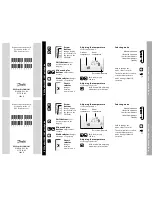
Regardless of the communications connection (Ethernet or cellular), a failed attempt results in the register data packet
being saved on the local micro SD card
12
. The number of retries will depend upon the network connection type.
When there is bad cellular signal strength or there is no Ethernet connection, the transmission attempts are not counted as
failed attempts to send data. Only when there is a good network connection and there are 10 failed attempts will the
controller archive the data on the SD card. Data archived on the SD card must be manually retrieved.
10.6.1 Ethernet Push Retries
With an Ethernet-based network connection, the DXM Controller retries a message five times. The five retry attempts
immediately follow each other. After all attempts are exhausted, the register data packet is saved on the micro SD card.
At the next scheduled time, the DXM Controller attempts to send the saved packet as well as the newly created register
data packet. If it cannot send the new register data packet, the new register data packet is appended to the saved file on
the micro SD card to be sent later. After 10 rounds of retries, the data set is archived on the micro SD card under folder
_sxi. No additional attempts to resend the data are made; the data file must be manually retrieved.
Using SSL on Ethernet will have no retries, but will save each failed attempt to the micro SD card until 10 failed rounds. At
this time, the register data packet is archived.
10.6.2 Cellular Push Retries
In a cellular-connected system there are no retries. Failed transmissions are saved on the micro SD card.
After 10 successive failed attempts, the data is archived in the _sxi folder. Send attempts with a low signal quality are not
counted against the 10 count limit. For example, if the cellular antenna is disconnected for period that the DXM controller
would have sent 20 messages under normal circumstances, all 20 messages would be saved and will be retried when the
antenna is reconnected. If the signal quality was good, but the cellular network was not responding, the DXM Controller
archives the register data packets after 10 failed attempts.
10.6.3 Event/Action Rule or Log File Push Retries
Event-based pushes caused by Action rules and locally stored log files sent using email follow the same process when
failures occur, based on the network connection. The failed Event-based messages are resent with the next cyclical
schedule or the next event message that triggers a push message.
10.6.4 Email and Text Message Push Retries
There are no retries for emails or SMS messages that fail to be sent from the DXM Controller.
10.7 DXM Modbus Registers
The DXM100-Bx Wireless Controller may have up to four internal Modbus slave devices:
DXM Internal Modbus Slave IDs (factory default)
Modbus Slave ID
Device
1
Gateway (PE5) or MultiHop (HE5) ISM Radio—MultiHop wireless devices connected to the internal MultiHop radio should
be assigned Modbus Slave addresses starting at 11.
199
Local Registers—Internal storage registers of the DXM Controller
200
I/O Base Board—All data and parameters for each input or output of the DXM Controller.
201
LCD Display—The user has access to the LED indicators on the DXM Controller.
All Modbus registers are defined as 16-bit Modbus Holding Registers. When connecting external Modbus slave devices, only
use Modbus slave IDs 2 through 198. The local registers, the I/O base, and the LCD slave IDs are fixed, but the internal
radio slave ID can be changed if needed.
12 Enable HTTP logging to save data on the SD card; this is the factory default. See SETTINGS -> LOGGING in the DXM Configuration Tool.
DXM100-Bx Wireless Controller Instruction Manual
78
www.bannerengineering.com - Tel: 763.544.3164





































